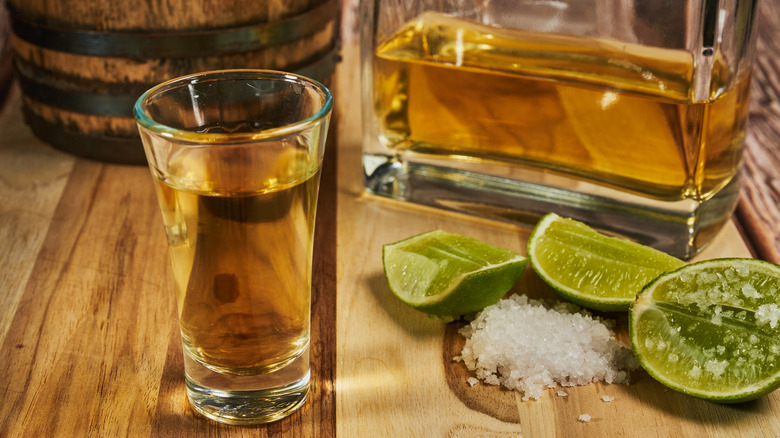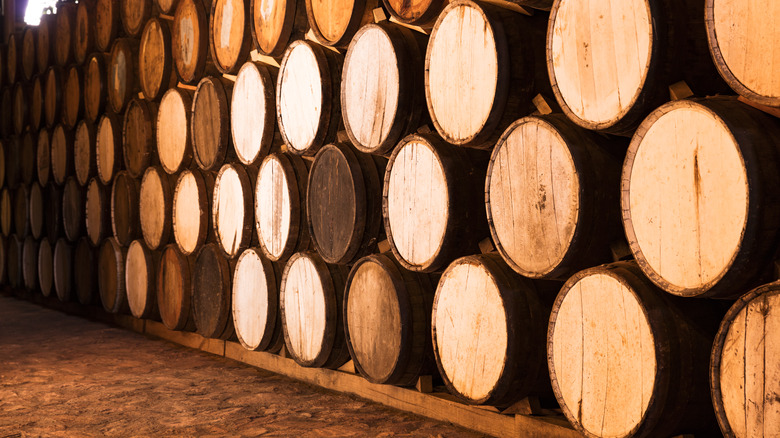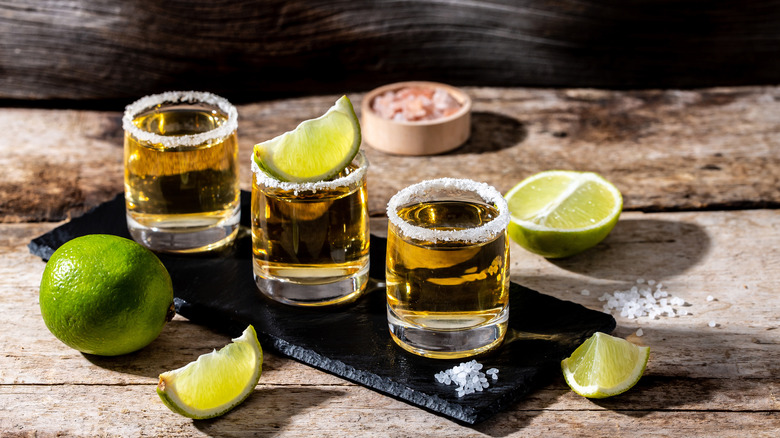Here's Why Reposado Tequila Is A Different Color Bottle To Bottle
Tequila sunrise, margarita, paloma, Mexican mule, or tequila and soda — whether you like it shaken, stirred, neat, or on the rocks, tequila is an essential component of any liquor cabinet. Made from the agave plant, tequila comes in many flavors and colors. In fact, even though they are all the same type of liquor, it's often easier to see the differences between tequilas rather than the similarities.
One thing you'll notice right away is that tequila is categorized as either blanco, reposado, or añejo. Each variety has its own characteristics in appearance and flavor. For example, the main difference between blanco and reposado tequila is that reposado is aged longer and in a different manner. The result is that blanco appears clear, while reposado offers a range of golden hues, which are intriguing considering they are made in essentially the same way. To understand why a reposado can appear lightly tinted or nearly amber, you must first understand how it's made.
Tequila is made from blue agave plants that, when harvested, are transported to a production facility where they are steam cooked before being fermented and distilled. At this point, some blanco tequilas are transferred to stainless steel drums or placed into oak barrels for up to two months to mellow before bottling. Reposado, on the other hand, heads straight to the oak barrel for aging.
Barrel aging tequila
Like whiskey and wine, tequila is primarily aged in wooden oak barrels. This is where it obtains its color as the compounds seep out of the barrel and are infused into the spirit. So, the short answer to the question about why the color of reposado varies so much is that sometimes the tequila only remains in the barrel for two months, and other times it may age in the barrel for a full year. If left in the barrel over 12 months, it becomes one of the many añejo tequilas.
Understanding this process, it's easy to see why reposado earned its name. Meaning "rested" or "restful" in Spanish, this tequila spends more time in contact with the oak than a blanco but less time than the añejo, which means "old" or "vintage." Line the three types up, and you'll typically be able to see the effects of color based solely on how long it was aged in a barrel. However, other factors can affect the color of a reposado, too. For example, new barrels will release more tannins than older wood. Since the oak casks used in tequila making usually had a previous job in whiskey or bourbon production, they can still impart color to the reposado, but not as quickly as if new barrels were employed for the task.
Variety is the spice of tequila
This natural process imparts coloring, and in general, the longer the tequila is in the oak barrel, the more color it will obtain. However, that's not the whole story. Reposado's color can also come from additives, primarily caramel coloring added before the fermentation process, which makes it look richer. Adding coloring gives the appearance of a naturally aged, premium tequila and, therefore, makes it seem more desirable.
Reposado may also get its color variations from the blending process. When barrels are filled and stacked in a warehouse, the reposado at the top of the pile is exposed to higher temperatures than the cocooned barrels at the bottom. Moisture levels vary throughout the stack as well. These factors affect the barrels and how they alter the reposado inside. Since each barrel produces a different flavor profile and color, the contents are blended for balance. The variation in colors between barrels then creates inconsistency across bottles when blended. Blending younger reposado with more mature barrels also changes the color. In the end, the definition of reposado is broad enough that the time spent in a barrel, the type of barrel, and how it's blended can all influence the final color and create variation from one bottle to another.


